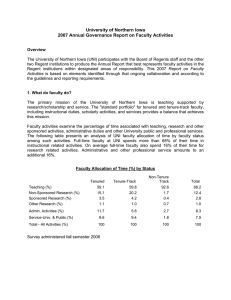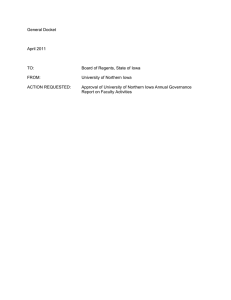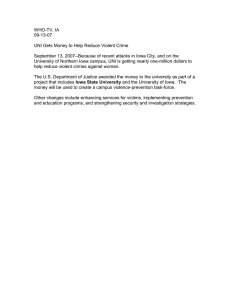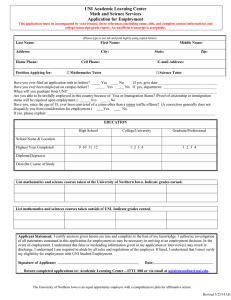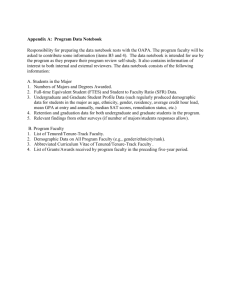General Docket April 2009 TO:
advertisement
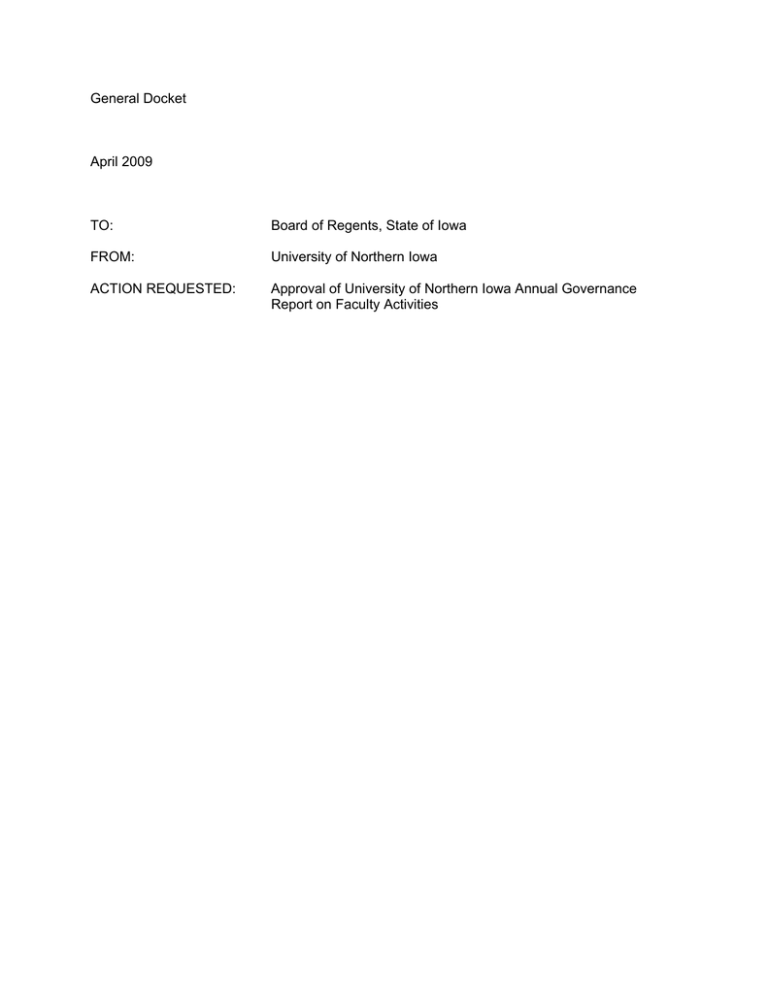
General Docket April 2009 TO: Board of Regents, State of Iowa FROM: University of Northern Iowa ACTION REQUESTED: Approval of University of Northern Iowa Annual Governance Report on Faculty Activities University of Northern Iowa 2009 Annual Governance Report on Faculty Activities Overview The University of Northern Iowa (UNI) participates with the Board of Regents staff and the other two Regent institutions to produce the Annual Report that best represents faculty activities in the Regent institutions within designated areas of responsibility. This 2009 Report on Faculty Activities is based on elements identified through that ongoing collaboration and according to the guidelines and reporting requirements. 1. What do faculty do? The primary mission of the University of Northern Iowa is teaching supported by research/scholarship and service. The "standard portfolio" for tenured and tenure-track faculty, including instructional duties, scholarly activities, and services, provides a balance that achieves this mission. Faculty activities examine the percentage of time associated with teaching, research and other sponsored activities, administrative duties and other University public and professional services. The following table presents an analysis of UNI faculty allocation of time by faculty status among such activities. Full-time faculty at UNI spends more than 62% of their time in instructional related activities. On average full-time faculty also spend 19% of their time for research related activities. Administrative and other professional service amounts to an additional 19%. Faculty Allocation of Time (%) by Status Tenured Tenure-Track Non-Tenure Track All Full-Time Faculty Teaching (%) 58.5 62.0 84.6 62.0 Non-Sponsored Research (%) Sponsored Research (%) 15.4 2.6 20.6 3.6 2.7 2.0 15.0 2.7 Other Sponsored Activities (%) 1.7 0.5 1.0 1.4 Admin. Activities (%) 12.5 3.6 4.2 9.8 Service-Univ. & Public (%) 9.4 9.7 5.5 9.0 Total - All Activities (%) 100 100 100 100 Survey administered fall semester 2008 2 Percent of time 100 84.6 80 60 62 58.5 40 20 15.4 2.6 1.7 12.5 9.4 20.6 3.6 0.5 3.6 9.7 2.7 2 1 4.2 5.5 0 Tenured Tenure-Track Non-Tenure Teaching (%) Non-Sponsored Research (%) Sponsored Research (%) Other Sponsored Activities (%) Admin. Activities (%) Service-Univ. & Public (%) Track As might be expected, tenured faculty, though spending most of their time in teaching activities, also make significant contributions to the University in scholarship and service roles as well as serving part-time in administrative functions. Probationary faculty devote proportionately more of their activity to teaching and scholarship and less to administrative functions. The goals in UNI’s Strategic Plan include “providing intellectually challenging experiences for students”, “maintaining a faculty distinguished by their creative and intellectually rigorous teaching and scholarship” and “focusing the involvement of the University in addressing critical local, state, national and global needs.” The faculty portfolio provides an ongoing history of each faculty member's assigned responsibilities and serves to illustrate how the individual faculty member fulfills the teacher/scholar model and contributes to the mission of the institution. Since faculty workload assignments are to some degree influenced by the academic discipline, each department specifically articulates its expectations for faculty in each of the three areas: teaching, research/scholarship & creative activity, and service. The faculty member's portfolio assignment is determined on an annual basis by consultation between the department head and the faculty member. The yearly performance evaluation process conducted at the departmental level provides the faculty member with written feedback that is consistent with her/his assignment and the established criteria for evaluation. Assigned responsibilities for the majority of faculty at UNI continue to be a balance of teaching, research/scholarship, and service. The standard load is to teach nine credit hours per semester and also to be actively engaged in research/scholarship & creative activities and service. 2. How many hours per week do faculty work? In a self-reported faculty survey administered Fall 2008 and Spring 2009 to all full-time faculty members, UNI faculty reported working an average of 54.3 hours per week. Tenured faculty work an average of 54.1 hours and the tenure-track faculty work at an average of 54.9 hours per week; non-tenure track faculty, who are on term appointments, work at around 46.9 hours per week. 3 Number of Hours Worked by Faculty Per Week Average Hours Worked Per Week Faculty Status Count Reported Tenured Tenure-Track Non-Tenure Track (Term) 202 80 35 54.1 54.9 46.9 Total 329 53.6 Average No. of Hours Worked by Tenured and Tenure-Track Faculty 282 54.3 Survey administered fall and spring semesters Total sample size was 583 and the average return rate was 57.1% Hours worked Per Week 80 60 55.6 54.9 50.4 54.8 40 20 0 Tenured Tenure-Track Non-Tenure Track (Term) All Faculty This survey was conducted for five weeks in the fall semester and for five weeks in the spring semester. Approximately twenty nine faculty (14 professors, 18 associate professors, 14 assistant professors and 12 instructors) were surveyed each of the 10 weeks for a total of 583 surveys. The surveys were colored-coded by week and were also coded to identify tenured or tenure-track faculty. 4 3. Who is actually teaching the students? Full Time Equivalent Students (FTE) Taught by Faculty Status Undergraduate Tenured Tenure-Track Non-T/TT Full-Time Term Instructors T/TT and Full-Time Subtotal Non-Tenure Track Graduate Assistants Total FTE % 4,988 1,635 694 7,316 2,775 81 49.0 16.1 6.8 71.9 27.3 0.8 10,172 Graduate FTE Total % 708 173 20 901 163 6 FTE 66.2 16.1 1.9 84.2 15.2 0.5 5,695 1,808 714 8,217 2,938 86 1,069 % 50.7 16.1 6.4 73.1 26.1 0.8 11,241 Undergraduate FTE = 15 credit hours Graduate FTE = 9 credit hours 4. Are tenured faculty teaching undergraduate students? At UNI, 71.9% of the undergraduate student credit hours are taught by tenured, tenure-track faculty and full-time term instructors. Less than 1% of student credit hours are taught by GAs. Undergraduate Student Credit Hours (SCH) Taught by Faculty Status SCH Undergraduate % Tenured Tenure-Track Non-T/TT Full-Time Term Instructors T/TT and Full-Time Subtotal Non-Tenure Track Graduate Assistants 74,813 24,525 10,403 109,741 41,627 1,212 Total 152,580 49.0 16.1 6.8 71.9 27.3 0.8 60 % of SCHs 50 49 40 27.3 30 20 16.1 6.8 10 0.8 0 Tenured Non-T/TT Full-Time Term Instructors Graduate Assistants Tenure-Track Non-Tenure Track 5 5. How much time do faculty spend on teaching students relative to doing research? Total Hours Worked by Faculty Per Week Tenured Non-Tenure Track Tenure- Track All Faculty Teaching Non-Sponsored Research Sponsored Research Other Sponsored Activities Admin. Activities Service-Univ. & Public 31.6 8.3 1.4 0.9 6.8 5.1 34.0 11.3 2.0 0.3 2.0 5.3 39.7 1.2 1.0 0.5 2.0 2.6 33.2 8.0 1.5 0.8 5.2 4.8 Total - All Activities 54.1 54.9 46.9 53.5 50 39.7 Hours spent 40 34 31.6 30 20 10 11.3 8.3 1.4 0.9 6.8 5.1 2 0.3 2 5.3 1.2 1 0.5 2 2.6 0 Tenured Tenure- Track Teaching Sponsored Research Admin. Activities NonTenure Track Non-Sponsored Research Other Sponsored Activities Service-Univ. & Public Tenure and tenure-track faculty on average spend more than 33.2 hours in instructional activities directly impacting students. These activities include preparation of lectures, grading papers, individual instruction, undergraduate student research, and curriculum development. Faculty spend an average of 5 hours in administrative activities including the administration of academic departments, academic colleges, instructional programs and student advising. Faculty also spend about 10 hours per week on sponsored and non-sponsored research intended to enhance their teaching related activities. These include research projects funded by state, federal, private sources, including outreach and service activities. 6 6. Why do our universities engage in activities besides teaching? Engagement by faculty in non-teaching activities including research, visual and performing arts, professional and community service, and economic development benefits student learning by bringing new knowledge and contemporary problem-solving experiences to the classroom. Such activities also help faculty to engage students more effectively in their major, in their future profession and in leadership development. Other instructional staff (i.e., non-tenured and nonprobationary faculty) devote nearly all of their time to teaching duties. University of Northern Iowa faculty engage in a broad range of service and outreach activities at the University, local, state, national and international levels; contributing their expertise to various government and non-governmental organizations and efforts. UNI faculty serve as officers for their professional organizations, provide leadership for state and local school and community improvement initiatives, and volunteer with international organizations. With an emphasis on experiential learning and internship experiences for students, faculty often include students in their University and community service activities. The Office of Sponsored Programs at the University maintains a database of research/grant activity. This data reflects the number and dollar value of externally funded grants and contracts requested by and awarded for faculty and staff for sponsored projects. The data does not include federal financial aid, grants for facilities construction and renovation, and nongovernmental grants administered by the University of Northern Iowa Foundation. During the fiscal year ending June 30, 2008, there were 224 sponsored project proposals submitted and 174 awards made to the University from federal government, state government, and private sources during the reporting period. Sponsored project awards total $36,771,923 which include $26,350,721 received from federal sources; $4,804,398 from state sources; and $5,616,804 from other sources. This is approximately a 125.9% increase in total award dollars since the previous report two years ago. 7 7. How do we know our universities are doing a good job? Measures of our success include accomplishments by our faculty, staff, students, and alumni as well as recognitions received by our academic programs, colleges, and the university as a whole. Few highlights are listed below: • The Carnegie Foundation granted the University of Northern Iowa a special designation in Community Engagement: Curricular Engagement and Outreach and Partnerships. This new designation reflects the foundation’s recognition of UNI’s strong commitment to community service on a local, regional, national and global level. • For the twelfth consecutive year, the University of Northern Iowa is ranked second in the "Midwestern Universities -- Master's" category for public universities, according to "U.S. News & World Report's" 2009 "America's Best Colleges" guidebook. The magazine's ranking criteria include peer assessment, academic reputation, retention, faculty resources, student selectivity, financial resources, graduation-rate performance, and alumni giving rate. UNI also ranked 17th on a combined list of public and private Midwest regional universities. • The Education Trust named UNI first among peer institutions nationally for overall high performance in graduation rates, and "Kiplinger's Personal Finance Magazine" has ranked UNI among the nation's "Top 100 Values in Public Colleges." • Over the past several years, in the CPA Exam, about 60 percent of UNI's accounting students who attempted all four parts of the exam within the calendar year they graduated passed all four parts on the first try. That's approximately five times greater than comparable national statistics. • Comparing the UNI Jazz Studies program with other programs across the nation, Arts Midwest saluted the UNI program as "one of the best." • Mary Losch, associate professor of psychology, and assistant director of our Center for Social and Behavioral Research, received the largest single grant in UNI's history - 11.5 million dollars over five years to implement 5 projects to reduce unintended pregnancy in Iowa. • Alexa Warrick, a double major in Biology and Spanish, was awarded a Goldwater Scholarship for her pursuit and potential contributions in a career in the natural sciences. • In the National Study of Student Engagement (NSSE) administered in the academic year 08-09 o 89% of seniors said that they would attend this institution if they started over again o 91% of seniors rated their entire educational experience as good or excellent • Nancy Aossey (Marketing '82, MBA '84), president and CEO of International Medical Corps (IMC), now a $100 million relief organization, received the 2007 Distinguished Alumnus Award from the American Association of State Colleges and Universities (AASCU) for dedication and commitment toward her cause. 8 Conclusions Overall, this 2009 UNI Annual Governance Report on Faculty Activities indicates the University continues to achieve its primary mission of teaching, while also effectively meeting, appropriate levels of accomplishment in the areas of research/scholarship and service. Faculty at the University continue to exemplify the teacher/scholar model and contribute to the accomplishment of the University's mission in accordance with its strategic plan. Additionally, this report reflects the University's continued utilization of the faculty portfolio model both as a management policy and as a performance evaluation tool. This strategy allows the University to more effectively organize, monitor, and report faculty activity. 9
